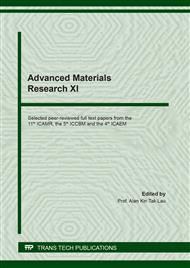[1]
R. Kleanmak: Ceramic Industry Department of Primary Industries and Mines (2004).
Google Scholar
[2]
S. Sirisunthorn: Ceramic Industry Status in Thailand: Ceramic Journal Vol. 14 (2010), pp.43-53.
Google Scholar
[3]
P. Pimkhaokhum, in: Ceramics, Chula Press Publishing, Bangkook, Thailand (2004).
Google Scholar
[4]
S. M. Hama, A. S. Mahmoud, and M. M. Yassen: Flexural behavior of reinforced concrete beam incorporating waste glass powder: Structures Vol. 20 (2019), pp.510-518.
DOI: 10.1016/j.istruc.2019.05.012
Google Scholar
[5]
Information on http://www.mtec.or.th/th/research/gsat/glassweb/gsat.asp.
Google Scholar
[6]
Information on http://www.pcd.go.th.
Google Scholar
[7]
W.Sangjan: Development of construction material production technology (decorative tiles and lightweight bricks) from waste glass: submitted to Department of Science Service Ministry of Science and Technology Vol. 57 (2009), p.46.
Google Scholar
[8]
European Commission: Environmental statistics and accounts in Europe (2010).
Google Scholar
[9]
E. Gemelli, S. Lourenci, M. V.Folgueras and N. H. Almeida Camargo: Assessment of industrial wastes in mortar layers deposited on stainless steel sheets of sinks: Cerâmica Vol. 50 (2004), pp.336-344.
DOI: 10.1590/s0366-69132004000400009
Google Scholar
[10]
M. Mageswari and B. Vidivelli: The Use of Sheet Glass Powder as Fine Aggregate Replacement in Concrete: The Open Civil Engineering Journal Vol. 4 ( 2010), pp.65-71.
DOI: 10.2174/18741495010040100065
Google Scholar
[11]
S. Nummesri: Utilization of solid waste by transforming into raw materials in ceramic works: report submitted to Chiang Mai Rajabhat University (2008).
Google Scholar
[12]
A. Al-Zubaidi and A. Al-Tabbakh: Recycling Glass Powder and its use as Cement Mortar applications: International Journal of Science and Engineering Research Vol. 7 (2016), pp.555-564.
Google Scholar
[13]
A. A. Aliabdo, A. E. M. Abd Elmoaty, and A. Y. Aboshama: Utilization of waste glass powder in the production of cement and concrete: Construction and Building Materials Vol. 124 (2016), pp.866-877.
DOI: 10.1016/j.conbuildmat.2016.08.016
Google Scholar
[14]
W.P. Prema Kumar, M.B. Ananthayya, and K. Vijay: Effect of Partial Replacement of Cement with Waste Glass Powder on the Properties of Concrete: International Journal of Structural and Civil Engineering Research Vol. 3 (2014), pp.1-6.
Google Scholar
[15]
M.S. Sayeeduddin, F.I. Chavan, and S. Patil: Suitability of Waste Glass Powder as a Partial Replacement of Cement in Fibre Reinforced Concrete: International Journal of Innovative Research in Sience and Engineering and Technology Vol. 5 (2016), pp.13553-13559.
DOI: 10.9790/1684-1304041621
Google Scholar
[16]
H. Warnphen, N. Supakata, and V. Kanokkantapong: The Reuse of Waste Glass as Aggregate Replacement for Producing Concrete Bricks as an Alternative for Waste Glass Management on Sichang Island: Engineering Journal Vol. 23 (2019), pp.42-58.
DOI: 10.4186/ej.2019.23.5.43
Google Scholar
[17]
T.C. Ling, C. S. Poon, and S. C. Kou: Feasibility of Using Recycled Glass in Architectural Cement Mortars: Cement & Concrete Composites Vol. 33 (2011), pp.848-854.
DOI: 10.1016/j.cemconcomp.2011.05.006
Google Scholar
[18]
H. Du and K. Tan: Properties of high volume glass powder concrete: Cement and Concrete Composites Vol. 75 (2016), pp.22-29.
DOI: 10.1016/j.cemconcomp.2016.10.010
Google Scholar
[19]
A.-Z. Aseel B, K. M. Shabeeb, and A. I. Ali: Study The Effect of Recycled Glass on The Mechanical Properties of Green Concrete: Energy Procedia Vol. 11 (2017), pp.680-692.
DOI: 10.1016/j.egypro.2017.07.095
Google Scholar
[20]
G. M. S. Islam, M. H. Rahman, and N. Kazi: Waste glass powder as partial replacement of cement for sustainable concrete practice: International Journal of Sustainable Built Environment Vol. 6 (2017), pp.37-44.
DOI: 10.1016/j.ijsbe.2016.10.005
Google Scholar
[21]
J. Halbiniak and M. Major: The Use of Waste Glass for Cement Production: IOP Conference Series: Materials Science and Engineering Vol. 585 (2019), pp.1-7.
DOI: 10.1088/1757-899x/585/1/012008
Google Scholar
[22]
Information on http://www.ceramicasarcola.com/scented-ceramic.
Google Scholar
[23]
Information on https://www.laboratorioolfattivo.com/en/product/scented-ceramics/.
Google Scholar
[24]
Information on https://www.mhesi.go.th/main/th/ 111-knowledge/work-of-most /dss/1645-2010-06-03-05-16-44.
Google Scholar


